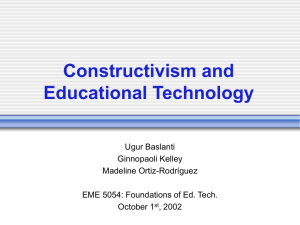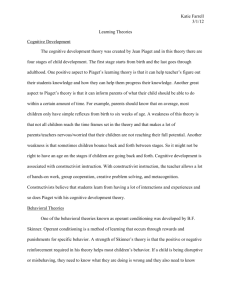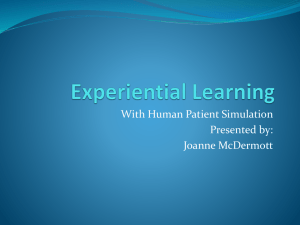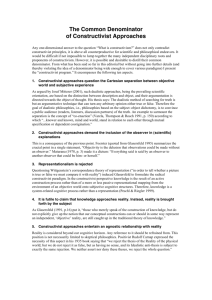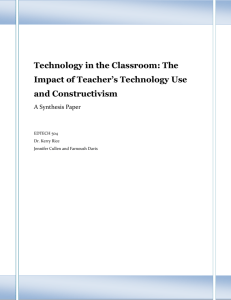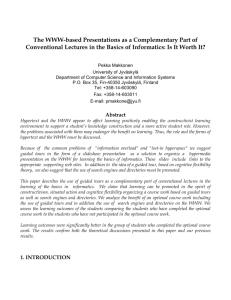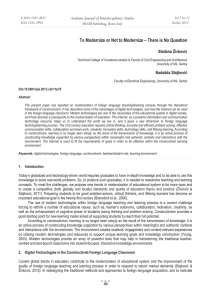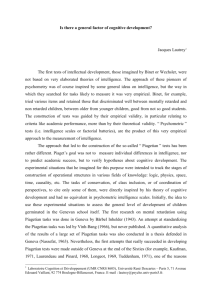General Implications of Cognitive Constructivism
advertisement
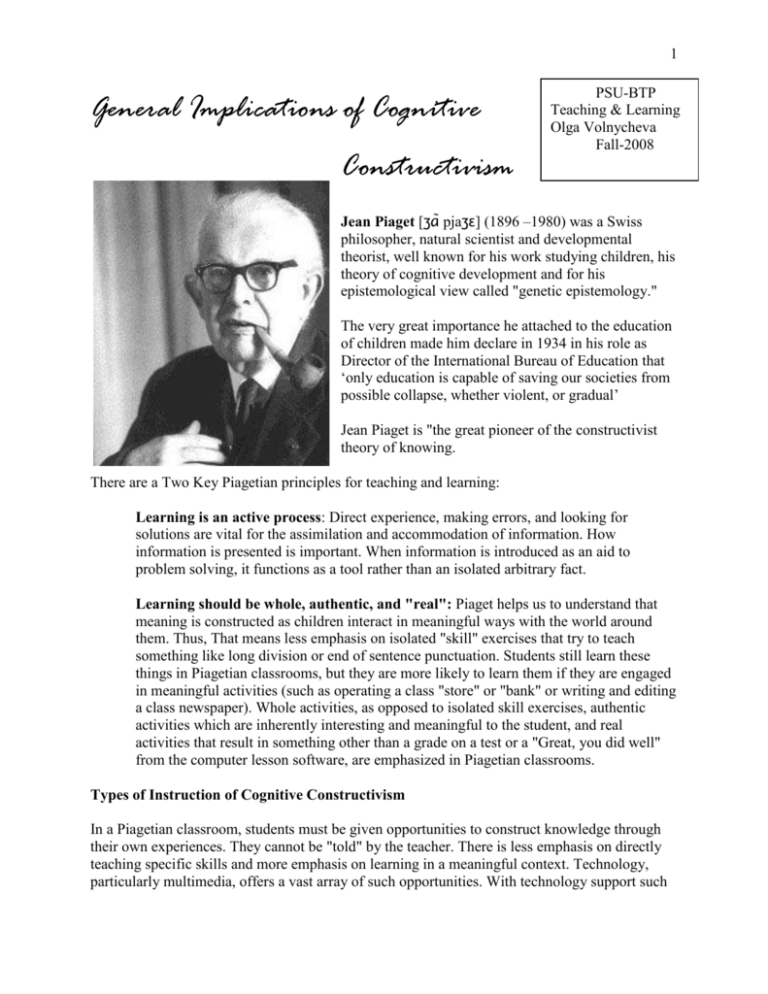
1 General Implications of Cognitive Constructivism PSU-BTP Teaching & Learning Olga Volnycheva Fall-2008 Jean Piaget [ʒɑ̃ pjaʒɛ] (1896 –1980) was a Swiss philosopher, natural scientist and developmental theorist, well known for his work studying children, his theory of cognitive development and for his epistemological view called "genetic epistemology." The very great importance he attached to the education of children made him declare in 1934 in his role as Director of the International Bureau of Education that ‘only education is capable of saving our societies from possible collapse, whether violent, or gradual’ Jean Piaget is "the great pioneer of the constructivist theory of knowing. There are a Two Key Piagetian principles for teaching and learning: Learning is an active process: Direct experience, making errors, and looking for solutions are vital for the assimilation and accommodation of information. How information is presented is important. When information is introduced as an aid to problem solving, it functions as a tool rather than an isolated arbitrary fact. Learning should be whole, authentic, and "real": Piaget helps us to understand that meaning is constructed as children interact in meaningful ways with the world around them. Thus, That means less emphasis on isolated "skill" exercises that try to teach something like long division or end of sentence punctuation. Students still learn these things in Piagetian classrooms, but they are more likely to learn them if they are engaged in meaningful activities (such as operating a class "store" or "bank" or writing and editing a class newspaper). Whole activities, as opposed to isolated skill exercises, authentic activities which are inherently interesting and meaningful to the student, and real activities that result in something other than a grade on a test or a "Great, you did well" from the computer lesson software, are emphasized in Piagetian classrooms. Types of Instruction of Cognitive Constructivism In a Piagetian classroom, students must be given opportunities to construct knowledge through their own experiences. They cannot be "told" by the teacher. There is less emphasis on directly teaching specific skills and more emphasis on learning in a meaningful context. Technology, particularly multimedia, offers a vast array of such opportunities. With technology support such 2 as videodisks and CD-ROMs, teachers can provide a learning environment that helps expand the conceptual and experiential background of the reader. Although much of the educational software created in the 1970s and 1980s was based on behavioral principles, much of the new multimedia educational software is based on constructivist theories. Technology provides essential tools with which to accomplish the goals of a constructivist classroom. In this section, you will explore several types of cognitive constructivist learning environments. Sometimes you will read only a description of an instructional approach, but you will also have an opportunity to explore some of the software that supports constructivist learning environments. Examples of Social Constructivist Classroom Activities Cognitive Constructivism & Social Constructivism: 1 - Anchored Instruction The anchored instruction approach is an attempt to help students become more actively engaged in learning by situating or anchoring instruction around an interesting topic. The learning environments are designed to provoke the kinds of thoughtful engagement that helps students develop effective thinking skills and attitudes that contribute to effective problem solving and critical thinking. Principles of anchored instruction: Learning and teaching activities should be designed around an "anchor" which is often a story, adventure, or situation that includes a problem or issue to be dealt with that is of interest to the students. Instructional materials should include rich resources students can explore as they try to decide how to solve a problem (e.g., interactive videodisc programs). Anchored instruction emphasizes the need to provide students with opportunities to think about and work on problems, which is an emphasis of cognitive constructivists. Anchored instruction also emphasizes group or collaborative problem solving, which is an emphasis of social constructivists. Cognitive Constructivism: 3 2 - Microworlds With microworlds, students "enter" a self-contained computer-based environment to learn. These microworlds may be supported by a larger classroom environment, but may also stand alone. For example, since children must construct or build their own reality, they need multiple representations, or views, of a concept or issue. A computer simulation of life in a particular culture, for example, might provide multiple representations by allowing players to take different roles such as worker, aristocrat, and ruler. A study of meteorology might involve trying to predict the weather as a meteorologist and playing roles, such as farmer, of people who use weather predictions. Cognitive Constructivism: 3 - Information Banks Information banks are sources or repositories of information. Traditional examples would include textbooks, teachers, encyclopedias, dictionaries, videotapes, videodiscs, etc. Technology expands the kinds and amount of information accessible and shorten the access paths. Information banks vary from background texts, to on-line databases, to individual experts (including teachers), to videodisks (e.g., the National Gallery videodisk) and to museums. Information banks are different from other "constructivist" learning environments such as anchored instruction because constructivist ways of teaching and learning are not necessarily "embedded" in the resource. You could, for example, develop a very behavioral way of using the Microsoft Encarta electronic encyclopedia. However, information banks are particularly powerful resources in a constructivist classroom because they can be used by students who are exploring issues, problems, and topics on their own Cognitive Constructivism: 3 - Symbol Pads Symbol pads are surfaces for the construction and manipulation of symbols and language. Examples include student notebooks, index cards, word processors, drawing programs, and database programs. Symbol pads are traditionally notebooks and blackboards. The symbol pads used in technology-enriched classroom are mostly standard word processing programs Cognitive Constructivism & Social Constructivism: 4 - Whole Language 4 The constructivist classroom is an environment where students build or construct their own knowledge. That does not mean they work alone or that they do not learn from what others have learned. To the contrary, many activities are hands-on and involve building on the work of others. Problem solving is often done within cooperative groups, and the tasks are meaningful to the lives of the students. This is the context of a whole language classroom. Proponents of this approach to teaching literacy stress the importance of relating what is new to what is known. After converting this to Piagetian jargon, we would say the student is given opportunities to assimilate & accommodate http://viking.coe.uh.edu/~ichen/ebook/et-it/cognitiv.htm






